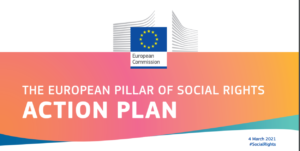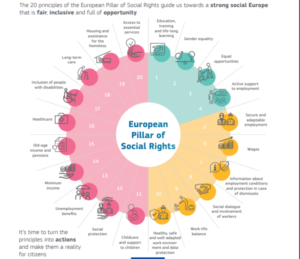
Cohesion Funds are considered, together with the Recovery and Resilience Facility, key financial tools to achieve the targets set by the Plan for 2030: unemployment reduction, increased training participation and reduction of poverty and social exclusion risk.
The European Pillar of Social Rights (EPSR) Action Plan, presented on 4 March by the European Commission, sets three targets for 2030:
- At least 78% of people aged 20 to 64 should be in employment
- At least 60% of all adults should participate in training every year
- The number of people at risk of poverty or social exclusion should be reduced by at least 15 million (decreased from the initial estimated 20 million target).
The European Commission considers those targets as “ambitious but realistic”, considering the post COVID scenario.
Member States are recommended to use Cohesion Funds, notably the ESF+ (the main funding instrument for the European Pillar of Social Rights) and ERDF together with the Recovery and Resilience Facility (RRF), which provides additional funds, to design measures that contribute to achieve these targets. Recovery and Resilience Plans to be submitted by Member States should include measures and programming to reach Action Plan Targets.
Country Specific Recommendations especially those regarding employment, youth, children poverty and social inclusion remain essential for Member States and will be followed up by the European Commission when analysing Recovery and Resilience Plans and Cohesion Funds (CF) programming.
Member States face the challenge of aligning national policies towards a greener and digitalised economy as set in EU Cohesion Policy Objectives, with specific targets set on National Strategies such as National Roma Strategic Policy Framework (NSPF) when programming both Cohesion Funds (ESF+ and ERDF mainly) as well as RRF included in Next Generation EU package.
In this sense, EPSR Action Plan addresses Member States to securte funds from both RRF and CF (mainly ESF+ and ERDF) to achieve the Action Plan recommendations, by allocating 25% of ESF+ to poverty reduction measures and at least 12.5% to reduce NEET’s rate.
The EPSR Action Plan builds on employment creation, considering the transition towards a green economy and digitalization model; training, upskilling and reskilling adults and poverty and social exclusion reduction.
In a mid-long term period, the Action Plan foresees enhancing a competitive economy in the EU, through Member States commitment with specific measures such as:
- reducing youth unemployment through training and employment alternatives. The EC recalls that youth unemployment reached 17.8% in 2020 across EU
- increasing upper secondary education participation and reducing early school drop-out
- reducing gender gap
- increasing formal early childhood education and care
- reducing the NEETs rate
- fostering non discrimination in employment access for vulnerable communities such as Roma
- reducing child poverty through the Child Guarantee development
- increasing social dialogue with social organizations and stakeholders participation

In order to monitor the implementation of these measures, new indicators have been included in the Social Scoreboard, such as Participation in learning experiences, child poverty rate or housing cost overburden. As secondary indicators, social expenditure through GDP percentage, unemployment benefits or children in formal child care are also included.
The Action Plan should reinforce Member States commitment with social inclusion and equality through adequate funding and mid and long term programming.
The European Commission launches recommendations and commitments towards the Porto Social Summit to be held in May 2021, urging Member States to maximize resources from the Recovery and Resilience Facility (RRF) and Cohesion Funds (CF) not only to address post COVID crisis scenario, but also for designing mid and long-term measures to foster employment and enhance capacities for an economy in transition.
Further information

